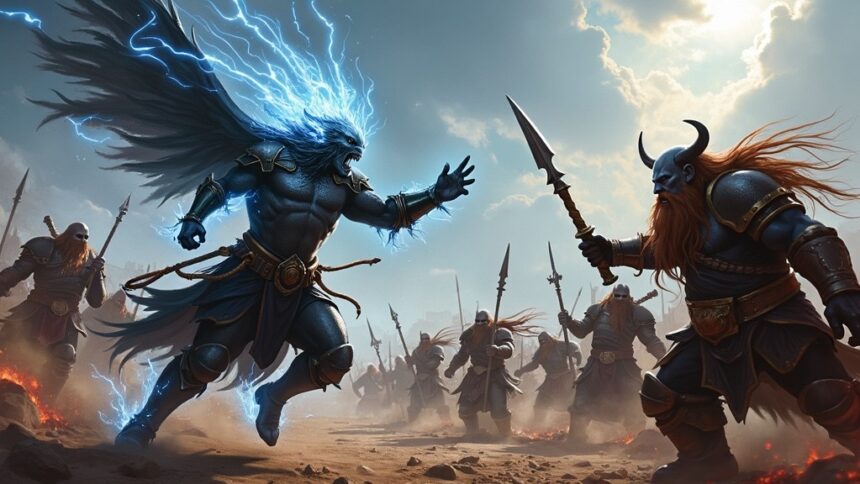As we approach the 2024 US Kings of War Masters, anticipation is building for what promises to be a fascinating and competitive event. Set to take place in Virginia from August 29 to September 1, this year’s tournament brings together top players from across the country, each vying for the title of Master. In this article, I will once again break down the high-level trends and notable lists, providing insights into what we can expect to see on the battlefield. As always, note that there’s a large manual component to downloading and parsing the lists, so if/when you spot errors, please let me know so I can fix them.
Faction Diversity and Participation
One of the standout features of this year’s Masters is the increase in faction diversity. There are 22 different factions represented this year, compared to 20 in 2023. The Faction Herfindahl-Hirschman Index (HHI), a measure of how concentrated the field is with specific factions, has dropped from 683 last year to 648 this year, signaling greater variety. This means that players will be encountering a wider range of armies, strategies, and unit combinations.
The most popular factions this year are Nightstalkers (7), Northern Alliance (7), and Ogres (6), each fielding multiple lists. This marks a shift from last year’s top factions, which were Dwarfs (8), Forces of the Abyss (6), and Elves (6). The prominence of Nightstalkers and Northern Alliance, in particular, reflects the meta’s evolution, with these factions bringing a mix of speed, resilience, and flexibility to the table.
Unit Composition and Strategy Trends
When we analyze the lists, certain trends emerge that highlight how players are building their armies and what strategies they might be prioritizing.
Unit Count: The average number of units per army is 14.5, with a high of 24 units in Travis Timm’s Goblin list, which exemplifies the “trash” style—overwhelming opponents with sheer numbers. On the other end, we see lists with as few as 10 units, focusing on quality over quantity.
Unit Strength: Unit strength is a crucial metric in Kings of War, especially for controlling objectives. The highest unit strength in the tournament is 30, seen in Nathan Cerone’s Nightstalkers and Nick Scibetta’s Riftforged Orcs (RFO). These lists are likely designed to dominate in scenarios requiring board control. On the lower end, some lists sit at a unit strength of 20, still a relatively small spread between high and low. In the 2023 US Masters, we saw a range from 15 on the low end to 32 on the high end (Jeff Radigan), so the spread is much narrower than in the past (even if the average is up slightly from 24.1 to 24.9).
Speed: Speed is another critical factor, particularly in a game where positioning can make or break a strategy. The fastest lists are Aaron Chapman’s OOTGL at 9.6 (!), and Ryan Hoffman’s Basileans at 9.2. These lists are built to outmaneuver opponents, strike key targets, and control the tempo of the game. In contrast, several Dwarf armies bring up the rear with an average speed of 4.3, relying on resilience and firepower over mobility.
Resilience: “Shots to six nerve” is a metric that shows how many ranged attacks a unit can take before it has a 50/50 chance of breaking. Dwarf variations take the top six spots in this category, with some lists reaching as high as 744 shots to six nerve, underscoring their reputation as tough, durable armies that can absorb significant punishment.
Quick stats
Speed
- Mean: 6.7
- Minimum: 4.3
- Maximum: 9.6
Expected Damage:
- Mean 62.3
- Minimum: 46.8
- Maximum: 81.8
Shots to Six Nerve:
- Mean: 356.1
- Minimum: 212
- Maximum: 744
Notable Lists and What to Watch
Picking favorites among the lists is always challenging, especially in a game as dynamic as Kings of War. I use composite metrics of objective (how well the list can play scenarios), movement (how fast and how nimble), defense (nerve pool, resilience, and defense), and offense (shooting and damage output). These composite metrics attempt (albeit poorly) to quantify the impact of the various factors to make for a more straightforward comparison.
Last year’s winner, Luke Fraser, showed that a well-rounded list can carry the day, even if it isn’t the flashiest on paper. I rated his Objective B, Movement B, Defense B, and Offense C+ last year, which was good enough to make the run.
This year, a few lists to watch:
Adam Ballard’s Trash Stalkers: This Nightstalker list brings a unique blend of overwhelming numbers and psychological warfare. With 17 units (all scoring) and a unit strength of 28, it balances quantity and quality effectively.
Mike Szedlmayer’s Nightstalkers: Another Nightstalker variant, but with a twist. What it lacks in sheer drops it makes up for with more resilience (359 shots to six nerve) backed by heal 14 and decent damage output (64.7 expected damage).
Marcelo’s Green Lady: Combining speed and punch, this list is fast and hits extremely hard, a combination that can be devastating in the right hands. And if last year’s tournament was any guide, these are the right hands. Avg speed of 8.5 paired with 71.1 expected damage and plenty of flying units makes this a tough alpha strike matchup.
Gabe Toth’s Crystal Dwarves: With an A+ defense rating and 157 total attacks, this list exemplifies the Dwarf playstyle of resilience and sustained offense. Sure, they’re slow as dirt (avg speed of 4.3), but great resilience and unit strength can make them powerful in the right scenarios.
Travis Timm’s Mountain Goblins: With 24 units and 232 total attacks, this list represents the horde approach, aiming to overwhelm opponents through sheer numbers. Plus after a few years off, Travis is ready to go and bring a nasty list to Masters.
The tournament format, consisting of 6 rounds with Swiss pairing, will test players’ ability to adapt to various opponents and strategies. While there are no specific scenarios or scoring systems favoring certain army compositions, the variety in list building suggests that players are prepared for a range of potential matchups. As the reigning master Luke Fraser himself said, however, there’s a healthy dose of luck in getting the right matchups when you actually get on the table.
Meta Shifts and Conclusions
The meta has shifted noticeably from last year. The reduction in sharpshooter units from 22 last year to just 9 this year is particularly significant (and where have all the scorchwings gone?). This indicates a move away from heavy shooting lists, perhaps in response to more resilient or faster armies that can close the gap quickly (and the nerf to scorchwings). Instead, we see more reliance on units like Goblin Rabble (21) and Pack Hunters (19), which emphasize mobility and board control. Slight upticks in drops and US support this narrative.
Recent rule changes and FAQs may have also influenced list building. The redone Northern Alliance and Twilight Kin factions have likely contributed to new strategies and army compositions. The annual list rebalancing has ensured that no single faction dominates the meta, promoting the diversity we see in this year’s tournament, an improvement with 22 factions represented this time around.
As the battlefield beckons, the stage is set for an epic clash of strategies and skills. Will the lightning-fast, hard-hitting armies overwhelm their opponents, or will the stalwart, resilient forces stand their ground and emerge victorious? With such a diverse array of factions and tactics, the 2024 US Kings of War Master title is truly up for grabs.
Don’t miss a moment of the action! Previous champions Adam Ballard and Luke Fraser are back, ready to defend their legacies against a new wave of challengers armed with innovative strategies and meta-defying lists. Will experience triumph, or will we witness the rise of a new Kings of War prodigy?
Mark your calendars for August 29 to September 1 and join the players in Virginia for the ultimate Kings of War showdown. Whether you’re a battle-hardened veteran or a curious newcomer, this is your chance to witness the pinnacle of competitive play, gain invaluable insights, and be part of Kings of War history.






